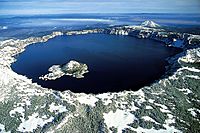Caldera facts for kids

A caldera is a huge bowl-shaped hole in the ground. It forms when a volcano erupts with great force, emptying its magma chamber. After the magma is gone, the ground above the chamber collapses inward.
Calderas might look like a volcanic crater. But a crater is made when rock blasts outward. A caldera forms when the ground falls inward. The word caldera comes from Portuguese. It means "cauldron" or a large cooking pot.
Some calderas are truly enormous. For example, the Yellowstone Caldera last erupted about 650,000 years ago. It shot out about 1,000 cubic kilometers of ash and rock. This covered much of North America in a thick layer of debris. To compare, the 1980 eruption of Mount St. Helens was 1,000 times smaller.
Contents
Giant Caldera Eruptions
Some of the biggest eruptions in Earth's history created massive calderas. These events can change the climate and environment for a long time.
Lake Toba Eruption
About 75,000 years ago, the Lake Toba volcano in Indonesia erupted. This was one of the largest known explosive eruptions in the last 25 million years. It released about 2,800 cubic kilometers of material. This huge eruption caused a "volcanic winter". It made the Earth's climate much colder for many years.
La Garita Caldera
Even bigger eruptions have happened. The La Garita Caldera in Colorado is an example. About 27.8 million years ago, it blasted out 5,000 cubic kilometers of rock and ash. This was from a single, massive eruption.
Where to Find Calderas
You can find groups of calderas in certain places. The San Juan Mountains in Colorado have many old calderas. They formed millions of years ago. The Saint Francois Mountain Range in Missouri also has ancient caldera remnants.
- The Ngorongoro Crater in Africa is actually a caldera.
Images for kids
-
Satellite photo of the summit caldera on Fernandina Island in the Galápagos archipelago.
See also
 In Spanish: Caldera volcánica para niños
In Spanish: Caldera volcánica para niños






